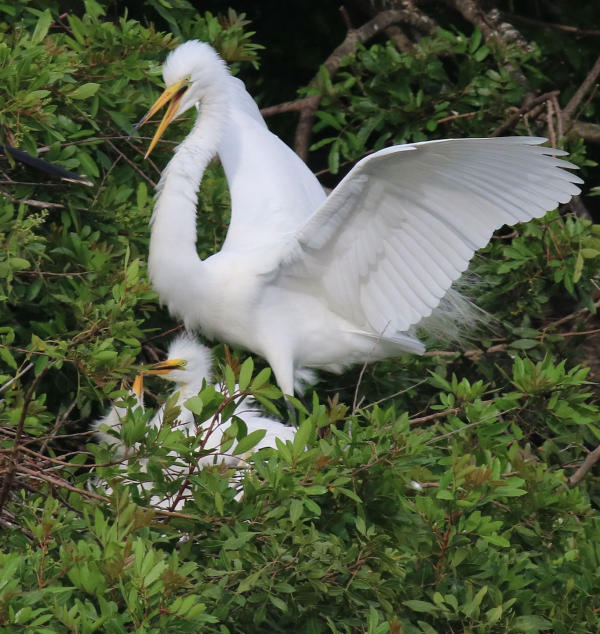

|
Great Egrets might be better named elegant egrets, for their pure white color and slow measured flight is truly elegant. Certainly, elegance was part of the reason a flying Great Egret was selected as the symbol for Audubon (formerly the National Audubon Society). Conservation themes were even more important in selecting the Great Egret, for the effort to protect the last populations of Great Egrets and other wading birds gave rise to the need for Audubon, and eventually to passing the Migratory Bird Treaty Act 100 years ago.
Egrets, herons, ibis and other birds were being killed at remarkable rates of hundreds of thousands – possibly millions – per year by market hunters that wiped out entire nesting colonies. Egret plumes and other feathers were in vogue for women’s hat fashions in North America and Europe, which was big business from the 1880s until about 1918 when the Migratory Bird Treaty Act was passed by Congress. Fashions were so fickle and egrets became so rare that at one time after the turn of the century, egret breeding plumes were worth five times the price of gold! Today, due to the education efforts and political work of Audubon and the support of enlightened Americans and Congress, Great Egrets and other plume species are common and widespread once again.
It’s always fun to watch the progress of hunting Great Egrets as they wade through shallow water hunting for small fish and tadpoles, but for real excitement, visit a Great Egret nesting colony to experience the sights and sounds of these interesting wading birds displaying and calling, building nests, flying back and forth with food or protecting growing nestlings. Nesting colonies may number in the tens, but some are colossal, with nests numbering in the thousands. Nesting colonies may also include other colonial nesting birds such as Great Blue Herons, Snowy Egrets, Anhingas and White Ibis, making a visit to a nesting colony all the more exciting.
Range: Southern Canada to Panama in North America.
Habitats: Primarily shallow wetlands, plus shorelines of rivers and oceans and associated uplands.
Mating: Pairs remain monogamous during the nesting season.
Nest Sites: The platform nest is built of sticks in bushes or trees adjacent to a wetland or watercourse. They usually nest in a colony that may include from a few to thousands of Great Egrets.
Clutch Size: 2 to 5 light blue or light blue-green eggs.
Incubation Period: 23 to 26 days. Adults share incubation, which they begin as soon as the first egg is laid, resulting in staggered (asynchronous) hatching.
Nestling Period: Adults share feeding and caring for the nestlings that leave the nest in about 3 weeks. Family groups remain together for several more weeks as the nestlings learn to forage and fly.
Fledging: About 7 weeks.
Food: Primarily small aquatic animals including fish, frogs, crayfish, large insects and large insect larvae. Sometimes Great Egrets hunt in open grasslands where they catch mice and voles, large insects and frogs.
Conservation Status: Great Egrets are common in many areas and have been expanding their range northward after recovering from plume hunting a century ago, and the effects of DDT during the 1960s.